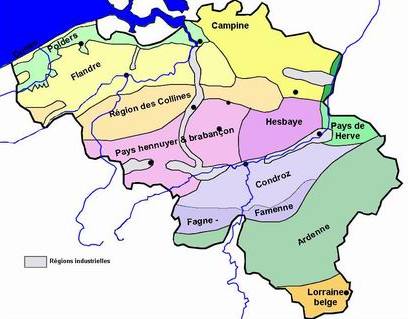- ,091 km²
To get the total area of Belgium, the surface of the Brussels-Capital Region should be added to the list, since Brussels is not in any Belgian province anymore since the province of Brabant has been split. Belgium has also 3,462 square kilometres of sea territories in the North Sea. On 29 May 2000, 2,000 square metres were granted by the Netherlands to Belgium (a piece of land in Zelzate along the Ghent-Terneuzen Canal).
Compared to other countries, Belgium is 1.5 times larger than Wales in the United Kingdom and about the size of Maryland in the United States. Belgium is actually used as an unusual unit of measurement in comparing country sizes.
Physical geography
Belgium has three main geographical regions: the coastal plain in the north-west, the central plateau, and the Ardennesuplands in the south-east. The coastal plain consists mainly of sand dunes andpolders. Polders are areas of land, close to or below sea level that have been reclaimed from the sea, from which they are protected bydikes or, further inland, by fields that have been drained with canals. The second geographical region, the central plateau, lies further inland. This is a smooth, slowly rising area that has many fertile valleys and is irrigated by many waterways. Here one can also find rougher land, including caves and small gorges. The third geographical region, called the Ardennes, is more rugged than the first two. It is a thickly forested plateau, very rocky and not very good for farming, which extends into northern France and in Germany where it is named Eifel. This is where much of Belgium's wildlife can be found. Belgium's highest point, the Signal de Botrange is located in this region at only 694 metres (2,277 ft). Belgium has relatively few natural lakes, and none of any great size.
Rivers and lakes
All of Belgium is drained into the North Sea, except the municipality of Momignies(Macquenoise), which is drained by the Oise river into the English Channel. Three major rivers flow into the sea: the Scheldt (200 km in Belgium, 350 km in total), theMeuse (183 km in Belgium, 925 km in total) and the Yser (50 km in Belgium, 78 km in total). Other rivers are the Rupel, Senne, Sambre, Lesse, Ourthe, Lys and Dijle. The main lakes include the Lake Genval, Lake Bütgenbach, Lake Eau d'Heure and Lake Robertville.
Artificial waterways
Belgium has also many artificial waterways or canals, among others the Brussels-Scheldt Maritime Canal, the Brussels-Charleroi Canal, the Canal du Centre and theAlbert Canal.
Climate
The Belgian climate, like most of northwest Europe,[3] is maritime temperate, with significant precipitation in all seasons (Köppen climate classification: Cfb; the average temperature is 3 °C (37.4 °F) in January, and 18 °C (64.4 °F) in July; the average precipitation is 65 mm (2.6 in) in January, and 78 mm (3.1 in) in July).[4] Belgium has mild winters and cool summers and is rainy, humid and cloudy
Belgium's highest point is the Signal de Botrange at 694 meters above the sea level. Other hills in Belgium include the Kemmelberg (159 m high) and the Koppenberg (77 m high) both known as being climbed by professional cyclist during the annual cycling road races of respectively Gent–Wevelgem and the Tour of Flanders.
Extreme points
This is a list of the extreme points of Belgium, the points that are farther north, south, east or west than any other location.
- Northernmost point — Dreef, municipality of Hoogstraten,Antwerp
- Southernmost point — Torgny, municipality of Rouvroy,Luxembourg
- Westernmost point — De Panne, West Flanders
- Easternmost point — Krewinkel, municipality of Büllingen, Liège
- Highest point — Signal de Botrange (694 m)
- Lowest point — De Moeren (-3 m)
The Belgian National Geographic Institute calculated that the central point of Belgium lies at coordinates 50°38′28″N 4°40′05″E, in Nil-Saint-Vincent-Saint-Martin in the municipality of Walhain.
Human geography- Demographics of Belgium
Political geography
Natural resources
Natural resources in Belgium include construction materials, silica sand andcarbonates. Belgium used to have coal mines. As of 2007, the land use was as follows:
- Arable land: 27.42%
- Permanent crops: 0.69%
- Other: 71.89%
As of 2003, the estimated area of irrigated land was of 400 km².



